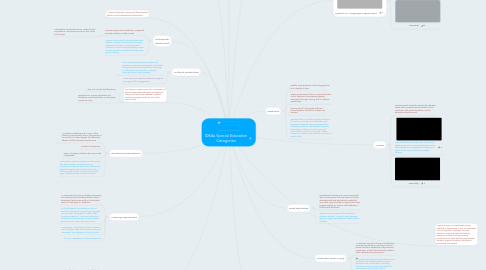
1. A severe orthopedic impairment that adversely affects a child's educational performance.
2. Simultaneous impairments, the combination of which causes severe educational needs that they cannot be accommodated in special education program solely for one of the impairments.
2.1. does not include deaf-blindness
2.2. Examples are: mental retardation and blindness, mental retardation & orthopedic impairment, etc...
3. Emotional Disturbance
3.1. A condition exhibiting one or more of the following characteristics over a long period of time and to a marked degree that adversely affects a child´s educational performace
3.1.1. inability to learn that cannot be explained by intellectual, sensory, or health factors
3.1.2. an inability to build or maintain satisfactory interpersonal relationship with peers or teachers
3.1.3. Inappropriate types of behavior or feelings under normal circumstances
3.1.4. a general pervasive mood of unhappiness or depression
3.1.5. a tendency to develop physical symptoms or fears associated with personal or school problems
3.2. Includes schizophrenia
3.3. Does not apply to children who are socially maladjusted
3.4. Preventative measures, behavioral intervention plan (BIP), positive reinforcement and incentives, collaborate with other professionals (psychotherapist, behavioral therapist, etc...) that work with student to determine specific ways to effectively educate the individual
4. Hearing Impairment
4.1. An impairment in hearing, whether permanent or fluctuating, that adversely affects a child's educational performance but is not included under the definition of "deafness"
4.2. Both oral (speech, lip reading and use of residual hearing) and manual (sign language) are used with and taught to children with hearing impairment. Voice and articulation training are recommended to help students to form sounds which they cannot hear.
4.3. Designating a note taker and use of assistive technology, sit close to the teacher, use of an interpreter, turn captions on during a video.
4.4. Do not underestimate child's intelligence!!!
5. Intellectual Disability
5.1. Significantly subaverage general intellectual functioning, existing with deficits in adaptive behavior and manifested during the developmental period, that adversely affects a child's educational performance.
5.2. Awareness to make a conscious effort to choose activities and words wisely. Carefully pick your words to reduce potential problems caused by student's limited vocabulary. Lots of patience!!!
5.2.1. Accompany verbal instructions with additional cues like showing pictures to reiterate spoken directions.
5.2.2. Divide tasks into smaller steps. Give immediate feedback to help child learn when they are doing something correctly.
5.3. CASE STUDY
6. Multiple Disabilities
6.1. stay mindful about medical conditions for classroom placement, being aware of student's intelligence level, use of assistive technology and alternate communication methods, hearings aids and sign language
6.1.1. physical therapy and occupational therapy to ease physical challenges, assigned aid to provide assistance, alternative textbooks (braille, audio, etc) to hearing and sign language
6.2. Closer look at the specific disability categories can supply further suggestions
7. Orthopedic Impairment
7.1. Includes impairments caused by a congenital anomaly, disease, or other causes
7.1.1. Poliomyelitis, bone tuberculosis, cerebral palsy, amputations, and fractures or burns that cause contractures
7.2. Keep in mind mobility devices (wheelchairs, walkers, crutches & canes) when arranging classroom furniture and assigning seats, schedule to avoid excessive walking, access to school elevator, assistive technology and speech therapy
8. Other Health Impairments
8.1. Having limited strength, vitality, or alertness, including heightened alertness to environmental stimuli, that results in limited alertness with respect to the educational environment, that ...
8.1.1. is due to chronic or acute health problems such as asthma, attention deficit disorder, or attention deficity hyeractivity disorder, diabetes, epilepsy, a heart condition, hemophelia, lead poisoning, leukemia, nephritis, rheumatic fever, sickle cell anemia, and Tourette syndrome
8.1.2. adversely affects a child´s educational performance
8.2. be aware of medical or nutritional needs, communicate with school nurse
9. Visual Impairment Including Blindness
9.1. An impairment in vision that, even with correction, adversely affects a child's educational performance
9.1.1. Includes both partial sight and blindness
9.2. early intervention, orientation and mobility training, arrangement of classroom furniture so that it is safe, sensory learning, assistive technology, large print or braille books
10. Applies to open or closed head injuries resulting in impairments in one or more areas, such as cognition, language, memory, attention, reasoning, abstract thinking, judgment, problem-solving, sensory, perceptual and motor abilities, psychosocial behavior, physical functions, information processing, and speech
11. Autism
11.1. Developmental disability significantly affecting verbal and nonverbal communication, social interaction that adversely affects a child's educational performance.
11.2. Applied behavioral analysis (ABA), structured teaching, speech and language therapy, social skills therapy and occupational therapy are all part of SPED services offered to autistic children.
11.3. Case Study
12. Deaf-Blindness
12.1. Simultaneous hearing and visual impairments, which cause severe communication and other developmental and educational needs that cannot be accommodated in special education programs solely for children with deafness or children with blindness.
12.2. Teachers must be aware of the individual student's abilities. American sign language, read lips, large print textbooks, braille, power of touch
13. Developmental Delay
13.1. Delays in one or more of the following areas:
13.1.1. physical development
13.1.2. cognitive development
13.1.3. communication
13.1.4. social or emotional development
13.1.5. behavioral development
14. Specific Learning Disability
14.1. A disorder in one or more of the basic psychological processes involved in understanding or in using language, spoken or written, that may manifest itself in the imperfect ability to listen, think, speak, read, write, spell, or to do mathematical calculations.
14.1.1. Does not include: learning problems that are primarily the result of visual, hearing, or motor disabilities, of mental retardation, of emotional disturbance, or of environmental, cultural or economic disadvantage.
14.1.2. Conditions include: perceptual disabilities, brain injury, minimal brain dysfunction, dyslexia, and developmental aphasia.

